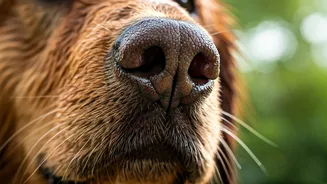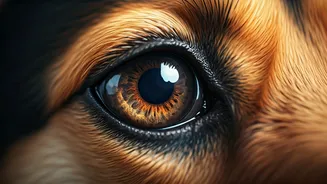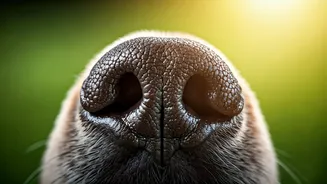The Power of Smell
Dogs possess an extraordinary olfactory system that surpasses human capabilities by a considerable margin. Their noses contain an impressive amount of
olfactory receptors, possibly hundreds of millions more than a human has. This explains their ability to detect scents at minuscule concentrations, potentially a million times lower than what humans can perceive. Their ability to independently analyze each nostril's sensory input and have separate areas in their brains dedicated to olfactory processing is a key element. These adaptations enable dogs to differentiate and identify scents with precision, showcasing their acute ability to navigate the world using smells.
Seeing the World
Contrary to popular belief, dogs do see color, though not exactly as humans do. Their vision is dichromatic, meaning they possess two types of cones, enabling them to perceive blue and yellow hues. This contrasts with humans' trichromatic vision, which allows them to see red, green, and blue. Dogs excel in detecting movement due to their enhanced visual processing speed, offering a clear advantage in observing things in action. Their eye structure, which also encompasses a wider field of view than humans, grants them superior peripheral vision, allowing them to notice events happening around them.
Hearing Like a Pro
Canine hearing surpasses human ability in numerous ways. Dogs are capable of hearing frequencies that are either higher or lower than those humans can detect. Moreover, their ears possess a flexible structure that allows them to rotate and pinpoint the precise direction of sounds with remarkable accuracy. This ability lets them rapidly identify the location of any noise, whether close or distant. The shape and structure of a dog's ear enable enhanced sound gathering, which in turn enhances their hearing capacity. This ensures they are acutely aware of their surroundings, making them highly attentive to environmental cues.
Taste and Flavor
While taste isn't as dominant a sense for dogs as smell, they still experience flavors. Their taste buds are sensitive to basic tastes such as sweet, sour, salty, and bitter. Dogs have a particular fondness for the flavor of meat due to their carnivorous ancestry. Though they don't share the same penchant for sweetness as humans, dogs do have a liking for certain sweet tastes, although less than humans. Despite having fewer taste buds compared to humans, they use this sense to navigate and choose what they eat based on what they experience.
The Wonders of Touch
Dogs have a well-developed sense of touch, distributed across their bodies through various nerve receptors. This sense enables them to feel varying textures, temperatures, and pressures. Their whiskers, which are specialized hairs, amplify their sense of touch, enabling them to navigate in low-light environments or narrow spaces. The sense of touch is essential for dogs, playing an integral role in social interactions. It helps them understand their environment, experience pleasure, and foster relationships with both humans and other animals.
A Super-Sensed World
The combination of their advanced senses creates a complex sensory landscape that shapes dogs' understanding of the world. Their superior olfactory abilities, along with keen hearing and vision, enable them to perceive aspects of the environment that humans can't. This sensory prowess gives them remarkable abilities, such as the capacity to track scents over long distances, detect subtle changes in their surroundings, and respond swiftly to stimuli. By appreciating their unique sensory world, people can better comprehend and communicate with their canine companions, fostering deeper understanding and strengthening the bond.













